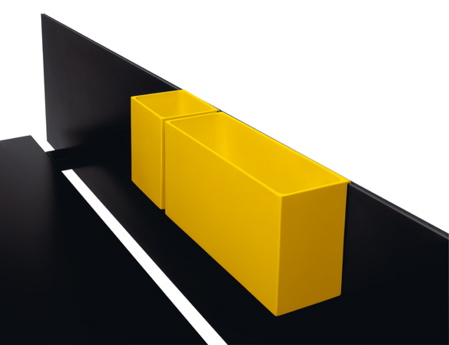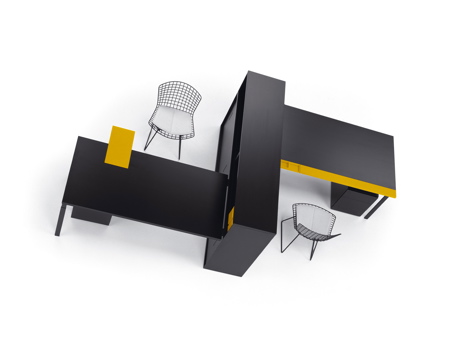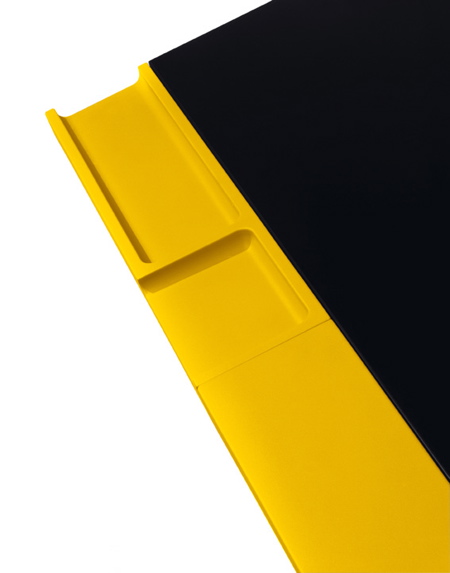
Piero Lissoni and Marc Krusin for Knoll
Designers Piero Lissoni and Marc Krusin have designed WA, a new office furniture system for Knoll International.


The word "WA" is used in several eastern cultures, apparently, and "its meaning has various interpretations, the broadest of which is harmony."

Below is an interview with the designers, followed by the usual press blurb:
--
Notes from Piero Lissoni and Marc Krusin, February 2007 (interview provided by Knoll International):
PL: “Our work is primarily about creating a visual silence. We concentrate on proportion and detail rather than a specific form. Lines and planes are carefully resolved into volumes, which in turn creates a visual harmony. “
MK: “The initial concept work for this project started nearly three years ago, and continued for several months. The brief was very technically demanding. WA had to connect on all four sides at any point. Desks also had to be adjustable in height, while the legs needed to be adjustable in width and in depth. The system was also to be compatible with a series of universal accessories and all other main elements."
MK: “The challenge with WA was to accommodate the rigorous performance criteria, but retain a visual silence. The requirements of office furniture are probably the most demanding that we have worked with. Even kitchens by comparison are relatively simple. “
MK: “We have created a very practical, a highly technically capable system that is still clearly in the Lissoni spirit. That gives me great satisfaction.“
MK: “I am very pleased with the design of the pedestal. It is extremely refined. We spent a long time at Knolls factory in Graffignana, talking directly to the technicians who worked the presses, sketching and discussing how the steel should be folded. We were delighted with the result. The prototype came out right first time round, something that we had never experienced before!"
PL: WA has two colour palettes, neutral and accent. For the larger surfaces a neutral palette of tone on tone is employed, ranging from white, to off white, through grey to black. The various tones sit comfortably side by side in any combination."
MK: “In addition to the neutral tones, a second palette of accent colours is applied to the storage door panels and accessories. The carefully chosen shades of red, yellow and blue are in stark contrast to the neutral palette. Later in the project it was felt that a completely neutral palette would also be desirable for such elements, so the tonal range was also extended to include the accessories."
MK: “I was born in London. I worked on placement with George Sowden in Milan, while I was studying. I moved to Milan permanently, almost immediately after graduation. There are many subtle differences between Italy and the UK, both socially and in terms of design. In design, I have learnt a lot from the Italians and their passion in many levels of society, for visual beauty. The Milanese can be very conservative leading to homogeneity in everyday life. Generally Brits are more liberal minded and more confident with sub cultures and ethnicity. This can be of enormous benefit to Italian employers."
--
Knoll launches WA, a furniture system designed by Piero Lissoni with Marc Krusin.
WA offers silent design that works in harmony with different interiors. It has a simple graphic language where vertical and horizontal planes are treated as graphic blocks. This linear simplicity however, veils an extraordinary functional capability. WA has a patented 360o clip mechanism allowing for total adaptability and manoeuvrability. There are no pre-determined fixing points and the system is unrestricted by modular sizes.
WA is a complete environment incorporating tables, screens, storage and meeting furniture. Tables can be entirely freestanding or linked to other elements of the range, including storage units. Ergonomic accessories called ‘soft parts’, soften the interface between the user and the work surface and bring a level of comfort to the desk that has previously only been expected from seating.
Knoll has worked closely with Piero Lissoni and Marc Krusin to create a high quality product that reflects a rigorous adherence to Knoll’s design principles. This is their first joint collaboration with Knoll International, and follows in Knoll’s long heritage of working with outstanding designers of the day.
Knoll has been a pioneering force in the world of contemporary furniture since it was founded nearly seventy years ago by Florence and Hans Knoll. Famed for its associations with architects, its founders created a new market for functional furniture with exceptional form. Previous Knoll collaborators include Mies van der Rohe; Harry Bertoia; Eero Saarinen and Marcel Breuer amongst many other illustrious architects and designers. Florence Knoll’s philosophy that “Good design is good business" remains a key company message to this day.
WA simplicity of complexity: a narrative
As the workplace and the world around us grow in complexity, there is a need for visual clarity. Simplicity is the goal, whilst simultaneously enhancing both performance and function.
Piero Lissoni and Marc Krusin have created a furniture system with a simple graphic language. The desks and storage are freestanding primary forms. They are essential furniture building blocks which can be adjustable and modular, yet harmonious. A flexible network of possibilities emerges from these simple geometric shapes. Technical complexity, engineered into simplicity.
The simplicity of complexity
Tone and colour. Simple geometric forms. The WA landscape consists of lines, squares, rectangles and circles that combine freely in a Mondrian like collage. A subtle emphasis on the horizontal gives WA a quiet elegance. Simple.
Yet WA also offers great technical capability. Worksurfaces can be connected to other worksurfaces, or any other component, at any point, 360 degrees. The same principle applies to the vertical axis, providing endless possibilities, connections and permutations. WA is engineered to flex in three dimensions. Complex. But simple.
How does it work?
A perimeter rail is fitted to the underside of every worksurface. Adjoining worksurfaces, storage and accessories can be connected at literally any point, on any side, 360 degrees. As there are no pre-determined fixing points, the system is unrestricted by modular sizes. Any size of screen, modesty panel or cable tray, for example, can be fitted to any size of desk, at any point, on any side.
The same principle applies to the vertical axis. Worksurfaces are adjustable in height. Cable trays and modesty panels are adjustable in height and depth.
Three dimensional flex. The complexity of simplicity.
The range
WA consists of simple height adjustable desks, screens, storage and meeting tables. Desks can be entirely freestanding or linked to storage units. Surface mounted Tech panels can be fully cable managed. Translucent freestanding screens, allow the division of space without excluding light, and are simple to gang and relocate.
In addition there is a range of ergonomic accessories called ‘soft parts’. Manufactured from polyurethane foam, employing technology normally associated with the automotive industry, soft parts soften the interface between the user and the work surface and bring a level of comfort to the desk that has previously only been expected from seating.
The word ‘Wa’ is used in several eastern cultures. Its meaning has various interpretations, the broadest of which is harmony.